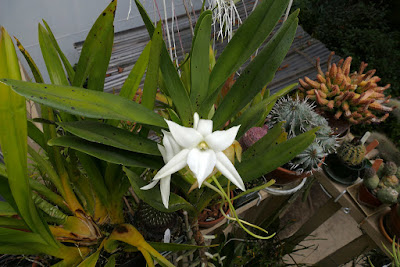Angraecum sororium is found in the central highlands in the region around Antananarivo as well as several other locations where it grows almost fully exposed on among boulders and granite outcrops at 1600-2200 meters.
Angraecum sororium also called as The Closely Related Angraecum, is a species of the genus Angraecum. This species was described by Friedrich Richard Rudolf Schlechter in 1925.
IDENTIFY ANGRAECUM SORORIUM ORCHID PLANT
Angraecum sororium is found in the central highlands in the region around Antananarivo as well as several other locations where it grows almost fully exposed on among boulders and granite outcrops at 1600-2200 meters.
It is a large sized, cool to cold growing lithophyte with an erect stem enveloped in maturity by several leafless dry, brown sheaths and carrying many, stiff, ligulate, in 2 upright rows, unequally bilobed apically, shiny bright green leaves.
The Closely Related Angraecum blooms in the summer on several, axillary, shorter than the leaves, 1 to 4 flowered inflorescence with obtuse bracts. The flowers of this species are similar to those of Angraecum magdalenae, though considerably larger, and they generally conform to the present-day concept of the perfect orchid flower, in terms of flatness, roundness, and lack of space between flora segments. The flowers are pure white with green spur, are of heavy substance, and have moderately good lasting qualities.
ANGRAECUM SORORIUM ORCHID PLANT CARE AND CULTURE
Cultural information should only be used as a guide, and should be to be adapted to suit you. Your physical location; where you grow your plants, how much time you have to devote to their care, and many other factors, will need to be taken into account. Only then can you decide on the cultural methods that best suit you and your plants.
Light:
Angraecum sororium needs a light level of 25000-40000 lux. Light should be bright but somewhat filtered or diffused, and plants should not be exposed to direct midday sun. Strong air movement should be provided at all times.
Temperature:
Summer days temperature at average 22-23°C, and nights temperature at average 12-13°C, with a diurnal range of 9-11°C. These plants should thrive if grown in the cool, moist airflow from an evaporative cooler.
Humidity:
The Closely Related Angraecum need the humidity o 75-80% most of the year, dropping to near 65% for a short time in spring.
Substrate, growing media and repotting:
Angraecum sororium may be grown in shallow, well-drained containers filled with a very open, fast-draining medium that has excellent drainage and is well aerated. You can use medium-sized fir bark or shredded tree-fern fiber and add varying amounts of chunky perlite and/or chopped sphagnum moss to keep the medium open and retain some moisture. Including charcoal in the mix also holds the medium open and prevents souring in the pot.
Plants should be repotted immediately if the medium starts to break down or whenever the plant outgrows its container. Repotting should be done just as new roots start to grow. This enables the plant to become reestablished in the shortest possible time.
Watering:
Rainfall is very heavy from late spring to early autumn. Amounts then decrease fairly rapidly at the beginning of the 5-month dry season, which lasts from late autumn to early spring. Cultivated plants should be watered heavily while actively growing. Water should be reduced after new growth is completed in autumn.
Fertilizer:
1/4-1/2 recommended strength, applied weekly when plants are actively growing. You can use a balanced fertilizer all year. Others, you can also use a high-nitrogen fertilizer from spring to midsummer and then switch to a high-phosphate formula in late summer and autumn.
Rest period:
Winter days temperature at average 17-18°C, and nights average 6-7°C, with a diurnal range of 11-12°C. Angraecum sororium need less water in winter, but they should not dry out completely or stay dry for long periods. Fairly regular early-morning misting between infrequently light waterings should provide sufficient moisture in most growing areas. Fertilizer should be reduced or eliminated until new growth starts and heavier watering is resumed in spring.















COMMENTS